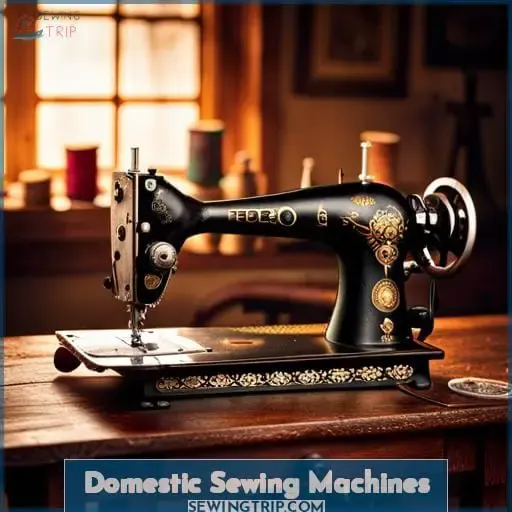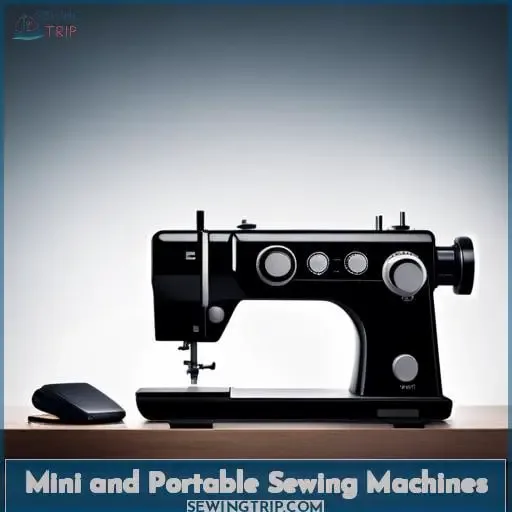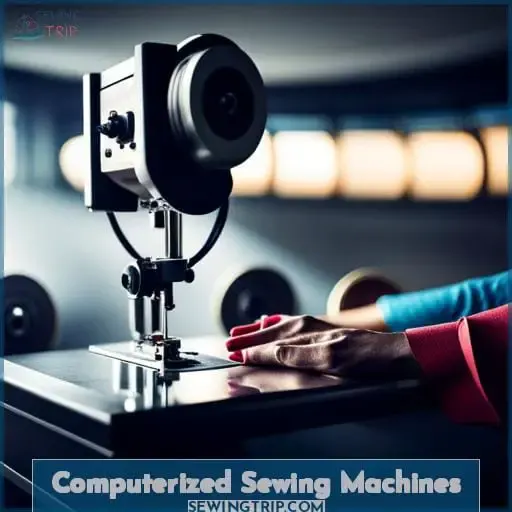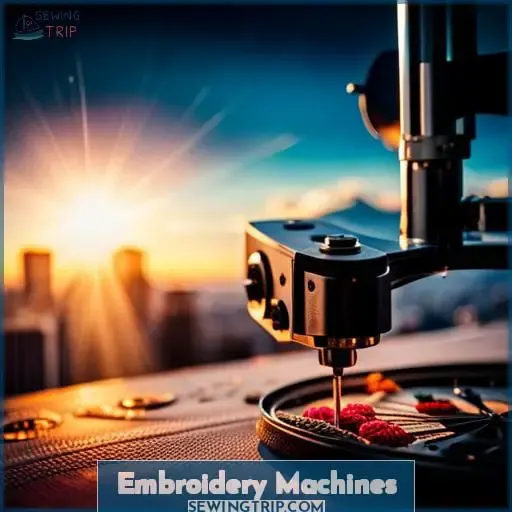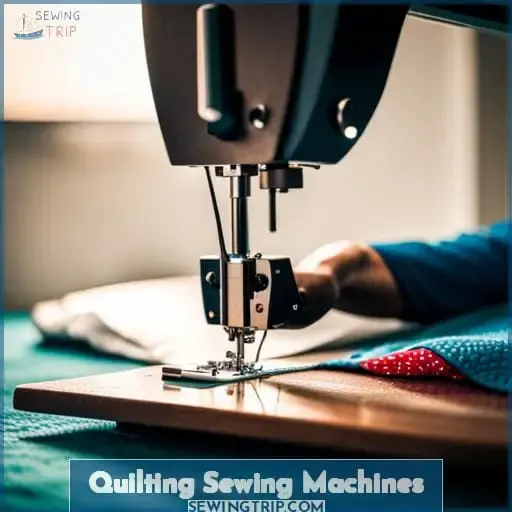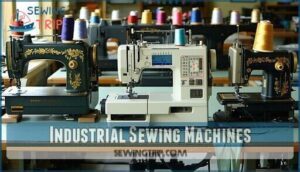This site is supported by our readers. We may earn a commission, at no cost to you, if you purchase through links.
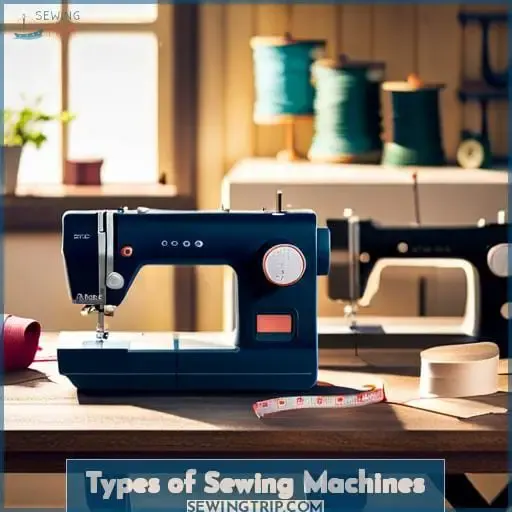 There are so many types of sewing machines out there – it can get overwhelming fast.
There are so many types of sewing machines out there – it can get overwhelming fast.
From basic mechanical models to computerized wonders, you’ve got options for embroidery, quilting, clothing construction, and more. We’ll guide you through domestic machines to tailor your home sewing and industrial powerhouses that churn out miles of perfect stitches for professionals.
The key is matching the machine to your skills and projects. Once you do, you’ll wonder how you ever sewed without it. So get ready to find your perfect sewing sidekick. With the right machine, you’ll create professional-looking pieces and unleash new creative possibilities.
Let’s get sewing!
Table Of Contents
Key Takeaways
- Domestic sewing machines, mini and portable sewing machines, computerized sewing machines, and embroidery machines are some of the different types of sewing machines available.
- Considerations for choosing a sewing machine include skill level, sewing purpose, types of stitches needed, electronic vs. mechanical options, and portability and space constraints.
- Home sewing machines offer basic features such as straight, zigzag, and decorative stitches, buttonholes for closures, LCD screens, automatic functions, and stitch options.
- Mini and portable sewing machines are compact and portable, suitable for basic straight stitching capabilities, with limitations and suitable projects to consider.
Domestic Sewing Machines
Whether you’re new to sewing or an experienced hobbyist, choosing the right domestic sewing machine is key. Basic home sewing machines offer essential features like straight and zigzag stitches, decorative stitches for buttonholes and decorative seams, suitable for crafts, clothing construction, and home decor projects.
You’ll have to decide between electronic models with multiple stitch selection via buttons or knobs, or mechanical machines with manual knobs and dials for simplicity and affordability.
Basic Features and Functions
You’ll love how a basic home sewing machine lets you easily sew straight stitches and zigzags for all your simple projects and buttonholes. With basic options like adjusting button length, needle capabilities, thread varieties, and sewing speeds, you can complete most maintenance basics and enjoy sewing with mechanical, electronic, or computerized options without needing industrial or embroidery functions.
Straight, Zig-zag, and Decorative Stitches
Here’s your chance to explore new creative terrain by stitching delicate blooms and bold geometric shapes with a domestic machine’s decorative stitches. Beyond zigzag, most domestic models offer multiple stitch width options for decorative stitch patterns to embellish your projects.
Adjusting tension properly prevents puckering on satiny fabrics when doing applique work. Zigzag’s variable width handles stretchy fabrics, prevents fraying seams, and creates buttonholes. Achieve perfection with the straight stitch by adjusting length and position for basting, seaming, and topstitching.
Leave the heavy lifting to industrial machines specialized for mass production across diverse textiles.
Suitable for Various Projects
Having buttons and a buttonhole is crucial for jackets and other closures, so domestic sewing machines with automatic buttonholing functions are ideal for crafting clothing and accessories with this feature.
- Sewing machine selection
- Project versatility
- Stitch variety
- Usage considerations
- Skill-appropriate options
Domestic sewing machines offer great versatility for diverse sewing, crafting, and mending projects. From basic straight and zigzag to decorative and automatic buttonhole stitches, electronic and computerized options provide the stitch variety needed for clothing, accessories, home decor items, alterations, repairs, and more based on your skill level and project needs.
Electronic Vs Mechanical Options
You’ve got electronic sewing machines with multiple stitch options operated by switches or mechanical sewing machines with simple knobs to suit your budget. When picking between electronic and mechanical domestic sewing machines, consider cost-effectiveness, efficiency, performance, user experience, and ease of operation.
Digitization advancements brought LCD interfaces, but mechanical options remain simpler and affordable.
| Type | Pros | Cons |
|---|---|---|
| Electronic | More stitches, LCD screen, digitization | Complex, less affordable |
| Mechanical | Simple, knobs, affordable | Limited features |
Ultimately, choose electronic for advanced features or mechanical for simplicity and value.
Mini and Portable Sewing Machines
As a beginner sewer, you’ll appreciate the compact design and portability of mini sewing machines. Though limited to basic straight stitching, their size makes mini sewing machines ideal for quick repairs, small projects, and getting started with sewing fundamentals before progressing to more advanced models.
Portable and Compact Design
You’ll appreciate their small size as you carry a mini sewing machine with you on trips or to classes.
- Lightweight and compact.
- Fits in a tote bag.
- Battery operated.
Mini portable sewing machines offer mobility and convenience with their compact size. Despite their portability, they reliably handle basic sewing tasks like hems, repairs, and decorative accents on garments, quilts, and crafts.
Their lightweight build allows easy transport in a bag or suitcase so you can sew clothing, quilts, or crafts anywhere.
Basic Straight Stitching Capabilities
Sew on, my friend, as these mini machines offer basic straight stitching for small projects, despite their compact size. Though limited in scope, they can handle simple seams and attach buttons with straightforward needle threading, fabric feeding, and reverse stitch controls.
Access the bobbin case to maintain even stitch tension. While mini machines lack fancy stitches, their portability empowers crafters to create mini masterpieces anywhere.
Limitations and Suitable Projects
Take it from me, these handy little sewing gadgets work wonders for simple stitches, but don’t expect them to handle heavy materials or complex projects. Their portability makes them ideal for basic mending and small projects using thin materials.
You’ll be limited to straight stitching and maybe a few basic zigzag designs. Stick to simple repairs, doll clothes, placemats, or other small items. Forget heavy denim, layered quilts, or anything requiring special stitches – leave those projects to full-size, computerized machines.
Computerized Sewing Machines
As an experienced seamstress, I can tell you that computerized sewing machines are more advanced with handy features like LCD screens, automatic functions, and a wide range of stitch options. These high-tech sewing machines even allow you to import custom embroidery designs via USB for unlimited creative possibilities.
Advanced Features and Automation
Didn’t your new computerized sewing machine make finishing that quilt so much easier with its wide selection of decorative stitches and ability to import embroidery designs right from your laptop? Powerful processing enables computerized sewing machines to offer advanced automation and customization options like AI-powered stitch recommendations and customization of stitch length, width, and tension.
Large touch screens provide intuitive controls while Wi-Fi and app connectivity let you wirelessly transfer embroidery designs. With advanced computer-controlled cycle stitching, you can effortlessly execute intricate embroidery stitches and long-arm quilting designs.
Computerized sewing brings high-tech precision and versatility to your sewing projects.
LCD Screens and Automatic Functions
You’ll see computerized sewing machines have LCD screens and automatic functions that make advanced stitching easier. The touchscreen interface allows you to easily select stitches and settings with just a tap.
Automatic thread tension and speed control take the guesswork out of adjustments. You can customize programs, upload designs via USB, and access a huge library of built-in stitches and patterns.
Overall, computerized sewing simplifies complex projects with versatile stitch options, drag and drop editing, and intuitive controls – without compromising creativity. Choosing the right computerized machine depends on your budget and interests like embroidery or quilting.
Wide Range of Stitches, Including Embroidery
You can choose from a buffet of stitches for any project, like a kid in a candy store picking their favorite treats. Computerized sewing machines empower your creative capabilities with a wide range of built-in and imported stitch options.
Enjoy automated embroidery and computerized design. Access decorative abilities from basic zig-zag to a professional finish. Explore custom stitch options and embroidered designs. Unleash your domestic sewing talents with advanced creative control.
Custom Program Import Options
Custom computerized sewing machines let you bring in personal embroidery designs from USB for creative flair. With program sharing and design libraries, these machines empower your artistic flexibility and customization.
Upload your own creative designs through USB and expand your artistic horizons. Take advantage of the creative expansion and explore new artistic frontiers with your custom computerized sewing machine.
Embroidery Machines
Embroidery machines are your one-stop solution for creative and beautiful stitchwork. With built-in designs and the ability to import more via USB, these specialized machines allow you to easily add decorative elements to any project.
Standalone options provide all the embroidery features you need, while integrated machines combine basic sewing functionality with the decorative capabilities of an embroidery unit.
Specialized for Decorative Stitchwork
Designed to elevate your embroidery game, these intuitive machines offer built-in stitch designs galore and seamless USB importing for unlimited creative possibilities. With an embroidery machine, you can explore an expansive world of detail by evaluating thread weights, comparing hoop sizes, and positioning stabilizers for your specialized sewing needs.
Forget safety stitching, flat seams, and reinforcing – go bold with placement, technique, and digitizing software to create one-of-a-kind embroidered designs on any fabric.
Built-in and Imported Designs
Embroidery machines allow you to create decorative designs from the built-ins or import extra flair through USB. The built-in library offers hundreds of design options to peruse. Simply scroll through the catalog on the LCD screen, select your desired pattern, edit it using the software if you wish, and let the machine handle the stitching.
Achieve quality embroidery without manual sewing. Import additional designs via USB to expand the pattern library.
Integrated or Standalone Embroidery Options
You’ll save space with an embroidery machine that is integrated into the sewing machine rather than a standalone unit. This built-in category offers convenience while retaining the versatility of embroidery.
Enjoy larger embroidery areas, custom design imports via USB, and simplified design manipulation. Adjusting tensions becomes seamless, enhancing stitch quality. Explore an array of decorative options, from intricate patterns to monograms, all within the same device.
Quilting Sewing Machines
Let’s get quilty! As a quilter, you know that specialty sewing machines are essential for handling large, layered quilting projects. Long-arm quilting machines provide the extra space needed to easily manipulate big quilts, while their durable construction allows you to stitch through thick batting with ease.
With the right quilting sewing machine, you’ll have the power and precision to create stunning quilted masterpieces.
Designed Specifically for Quilters
You can achieve your quiltmaking dreams with a quilting sewing machine built just for you. These machines provide the features and capabilities needed for quilting projects of all sizes. Specifically designed with the quilter in mind, they have a wide, flat bed to easily maneuver large quilt sandwiches, a powerful motor and needle system to sew through thick layers with ease, and special feet like the walking foot to ensure even fabric feeding.
With the right quilting machine by your side, you’ll create beautiful quilts to cherish for years to come.
Long-arm Machines for Larger Projects
Your long reach will glide gracefully over your grand quilt thanks to quilting sewing machines’ extra-large arms. These spacious workstations allow ample room for managing your miles-long masterpiece. Their built-in LED lights illuminate the surface so not one raw edge or pinprick escapes your notice.
With this commanding view of the textile terrain, no imprecise machine stitching can breach your empire of cozy comfort.
Handling Thick and Layered Materials
Because they’re built for handling thick and layered materials, quilting machines make sewing through multiple fabric layers a breeze. With their sturdy construction and specialized features like a larger work area and stronger motor, you can easily tackle projects using batting, backing, batting wadding, and multiple fabric layers without the domestic machine struggling.
Industrial Sewing Machines
You’ve been sewing for years and have a good grasp of industrial machines. These heavy-duty workhorses are built for mass production and can handle thick materials at high speeds. Brands offer specialty models like chain stitch, blind stitch, cover stitch, sergers, safety stitch, flat seam, and bar tack machines, each with specific functions for seams, hems, embroidery, and reinforcement.
While computerized options abound, vintage Singers and treadles have their charm too.
Heavy-duty Sewing Machines for Mass Production
Bro, these turbocharged sewing gizmos are built into tables for mass producing duds at warp speed.
- High-speed operation
- Heavy-duty motors
- Automated capabilities
They enable fast production of garments and other sewn goods. Safety features like automatic needle positioners reduce worker injuries. Maintenance costs are higher than domestic machines. Workers require training in operation.
Options include leather machines, safety stitch machines, feed of the arm, single-needle lock stitch, and even treadle sewing for off-grid power.
Different Types: Chain Stitch, Blind Stitch, Cover Stitch, Sergers, Safety Stitch, Flat Seam, Bar Tack
You’ll be amazed by the specialized industrial machines like sergers for finishing edges, flat seam units perfect for knits, and bar tack machines that reinforce high-stress points. Blind stitch and cover stitch machines create durable, invisible seams while safety stitch combines chain and overlock stitches for clean edges.
Sergers trim and overcast raw edges in one pass, ideal for stretchy knits or silks. Flat seam machines join knit materials with flat, durable seams on both sides. Bar tack units efficiently reinforce points under high tension for jeans, belts, or pockets.
Specific Functions and Applications
You can accomplish a wide range of industrial sewing techniques with specialized machines like chain stitch for seams, blind stitch to hide hems, cover stitch to finish edges, sergers for overlocking, safety stitch to combine chaining and overlocking, flat seaming on knits, and bar tacking to reinforce high-tension points.
OLD-SCHOOL machines still serve artisans well, enabling the creation of LINED LEATHER POUCHES, BUTTONED CUSHION COVERS, EMBROIDERED HANDKERCHIEFS, and DRESSES WITH POCKETS. Though less automated, VINTAGE sewing machines retain value for crafters seeking hand-operated tools to construct VELVET STUFFED TOYS and other treasures.
Vintage and Antique Sewing Machines
Among vintage and antique options, manual treadle machines and Singer’s iconic models remain popular for their decorative charm and nostalgic sewing.
- Lack of electricity
- Hand-operated mechanisms
- Ornate cast-iron bodies
- Nostalgic feelings
- Vintage decor
With technical knowledge and firsthand experience, I can say these vintage sewing machines offer inspiration through their decorative designs and evoke nostalgic feelings, allowing creative souls to appreciate the craft’s roots while decorating their homes.
The manual operation and antique mechanisms let us appreciate efficient sewing‘s history.
Frequently Asked Questions (FAQs)
What are the key factors to consider when choosing a sewing machine for beginners?
You’ll want to focus on an entry-level mechanical or electronic model with basic stitches. Look for adjustable settings, easy threading, and clear controls. Portable mini machines work for simple projects.
Prioritize durability and ease of use over advanced features until you build your skills.
How do I maintain and clean my sewing machine properly?
Clean your machine regularly by removing lint with a brush, wiping away dust, oiling moving parts, and changing needles often. Refer to your manual for proper oiling techniques and cleaning frequency for your model.
Avoid using harsh chemicals that could damage parts. Covering the machine when not in use keeps dust out. Proper maintenance prevents issues and keeps your machine running smoothly for years.
What accessories and feet are must-haves for my sewing machine?
Aside from needles and thread, the most useful accessories for your machine are presser feet. Change presser feet as needed for different techniques, such as zipper insertion or hemming. They allow you to sew specialty stitches that are not possible with the all-purpose foot.
Invest in a walking foot for managing slippery and layered fabrics when quilting.
Can I get my vintage sewing machine serviced and repaired if needed?
You can absolutely get your vintage sewing machine serviced and repaired if needed. Look for a technician in your area who specializes in vintage models. They’ll have the expertise to diagnose issues, service the machine, and source replacement parts.
Proper maintenance will keep your vintage sewing machine running smoothly for years to come.
What safety precautions should I take when using a sewing machine?
Always pay close attention while operating. Keep fingers away from moving parts. Don’t rush or get distracted. Wear safety glasses to protect your eyes. Avoid loose clothing that could get caught in the motor.
Make sure to turn it off when not in use. Maintain the machine well and replace worn parts. Unplug before changing needles or thread. Allow room for the material to move. Take care not to sew over pins.
Conclusion
Choosing the sewing machine most aligned with your needs/preferences keeps stitching with precision. From basic domestic models to computerized wonders, examine options closely. Portability suits some sewists, while quilters desire ample space.
Consider budget, projects, even nostalgia when selecting mechanical/digital features. Simple straight stitching or wild embroidery – creative sewers s쳮d with the machine fitted to them! Whatever your sewing dreams, the ideal model awaits discovery.

